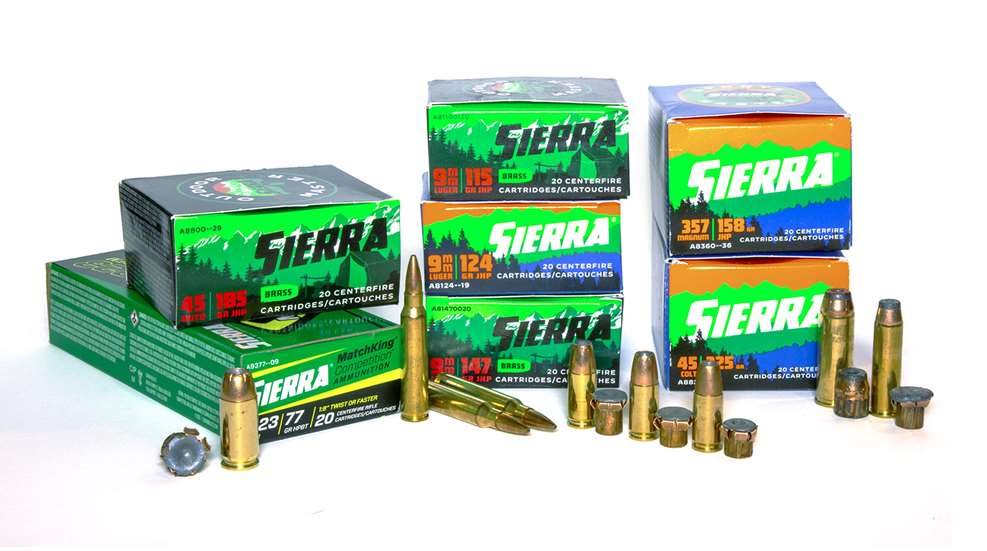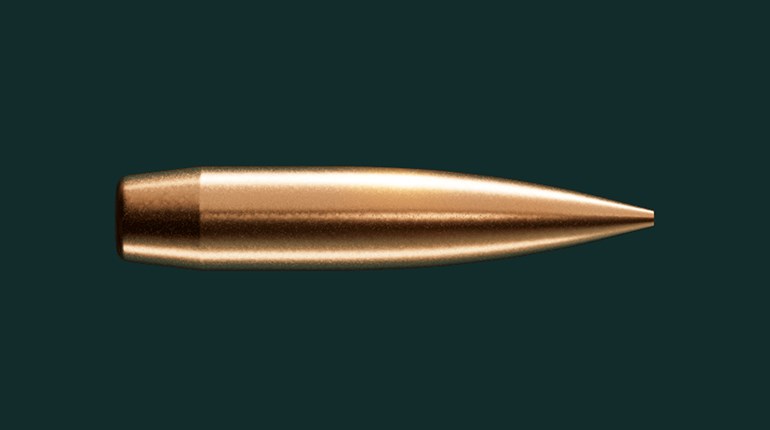
Sierra Bullets are now available loaded into the company’s own, complete ammu-nition, with MatchKing, SportsMaster and OutdoorMaster lines available for rifles and handguns alike.
Sierra Bullets was founded by three aircraft machinists in California in 1947, right at what’s considered to be the beginning of the golden age of handloading. During the next 40 years, Sierra Bullets became one of America’s premier bullet manufacturers. In the late 1980s, the company moved from California to Sedalia, MO. Sierra currently manufactures a wide assortment of bullets, and it also offers one of the best technical-assistance telephone services of any company, in or outside the firearm industry. What some shooters do not know is that in 2019, Sierra began manufacturing ammunition.
Sierra’s current line of ammunition includes rifle and handgun loads for recreational shooting, competition, hunting and self-defense. According to the company’s website, it offers loaded ammunition for a dozen rifle cartridges and eight pistol and revolver cartridges. I’ll admit, as someone who is supposed to keep the shooting public up to date on ammunition advancements, as far as Sierra is concerned, I’ve been derelict in my duties and am a bit embarrassed about it. I’ve used and trusted Sierra bullets for as long as I’ve been shooting and handloading, but it wasn’t until this year I conducted any experimentation with Sierra ammunition. Shame on me; this is good stuff.
Sierra currently offers five different ammo lines for rifles and handguns. The MatchKing Competition line utilizes Sierra’s famous MatchKing bullets and is available for .223 Rem., 6 mm Creedmoor, 6.5 Creedmoor and .308 Win. Its GameChanger line is for big-game rifle cartridges and is available in quite a few more chamberings. All of these loads utilize Sierra’s new GameChanger bullet, which is essentially a Sierra GameKing boattail bullet with a polymer tip. The Prairie Enemy line is also for rifles and is intended specifically for varmint hunting. Prairie Enemy ammunition is loaded with Sierra BlitzKing bullets.
The two other Sierra ammunition lines are SportsMaster and OutdoorMaster, and both contain rifle and handgun offerings. Sierra describes the SportsMaster line as having the feel and ballistic performance of expensive hunting ammunition, but in an affordable package for high-round-count training sessions. Its description of the OutdoorMaster line states it utilizes innovative components and production processes to deliver an economical and multi-purpose ammunition with hard-hitting terminal performance. There seems to be a bit of overlap here, and I was not completely clear on how these two lines differed.
To help sort out the confusion I reached out to Sierra. Essentially, these two ammunition lines are the same, but the SportsMaster line is only sold through Academy Sports. However, Sierra is in the midst of some rebranding, and these two lines will eventually be merged together under the THD (Train-Defend-Hunt) designation. You’ll probably see it available sometime in 2024.
Shooters demand a lot from factory ammunition, and at the top of the list is reliability. There were no failures to feed, fire or eject with any of the Sierra loads tested. Shooters also expect ammunition to deliver consistent velocities that are reasonably close to the velocities the manufacturer advertises. Ten shots from each of the seven loads tested were fired over a Caldwell G2 chronograph to establish an average muzzle velocity and standard velocity deviation. The smallest standard deviation recorded was 8.9 fps for the 124-grain 9 mm load. The highest was 27.2 fps for the 77-grain .223 Rem. load. The overall average standard deviation for all seven loads was a very respectable 17 fps.
Comparing a load’s actual muzzle velocity to its advertised velocity is tricky, because different guns produce different velocities, and barrel length matters, too. Sierra does not list the length of the test barrel used to establish advertised velocities, and I could not find an advertised velocity for the .357 Mag. and .45 Colt loads. The average difference in advertised and actual muzzle velocities for the other five loads was only 49 fps. This is not bad considering that the handgun loads for which I had an advertised velocity were tested from barrels no longer than 4.25 inches. The .223 Rem. rifle load was tested from a 22-inch barrel. Manufacturers typically use test barrels with lengths of 6 inches for handguns and 24 inches for rifles.
While the .223 Rem. MatchKing Competition load was not tested for terminal performance, the six handgun loads were fired into blocks of Clear Ballistics from a distance of 10 feet. For personal protection, most consider penetration between 12 and 18 inches optimal, especially when combined with bullet upset of 1.5 times the unfired diameter. With the exception of the .45 Colt load, all the handgun loads met the penetration threshold, and they did so with moderate velocities. Bullet upset was, on average, closer to 1.35 times the unfired diameter. This does not mean these loads would not be effective, it’s just a moderate-velocity approach to terminal performance that leans more toward penetration than bullet upset. The projectile used in the .45 Colt load penetrated quite deep, but did not upset at all. This is not uncommon with .45 Colt loads that only reach lower velocities.
What was really impressive about this ammunition is how well it made little groups on target. Out of my New Ultra Light Arms Model 20 rifle in .223 Rem., the 77-grain load delivered consistent sub-MOA performance. All the handgun loads shot well, too, and the 147-grain 9 mm load was a tack-driver. The .45 Colt load delivered the largest average group size of all the loads tested, but it was fired from a single-action revolver with rudimentary sights. After shooting from a sandbag rest at 10 yards, I took all four handguns I used for testing and stepped back to 25 yards. Shooting offhand at that distance, I could consistently ring an 8-inch steel plate with every one of the Sierra loads.
My major complaint with Sierra’s new line of ammo is information. The ammo side of the website is not very user friendly, and in some cases a bit vague. Also, some of the listed loads are missing ballistic information. Sierra’s site does have a page that explains the seven classifications of rifle and three classifications of pistol bullets it offers, and there’s also some good information on bullet design.
All of Sierra’s ammunition is packaged in brightly colored, attention-getting boxes, but none of the boxes show any ballistic information, even as basic as velocity, which is now mostly the industry standard on ammunition packaging. Sierra is unquestionably making some fine ammo; it just has work to do when it comes to telling you about it.




































